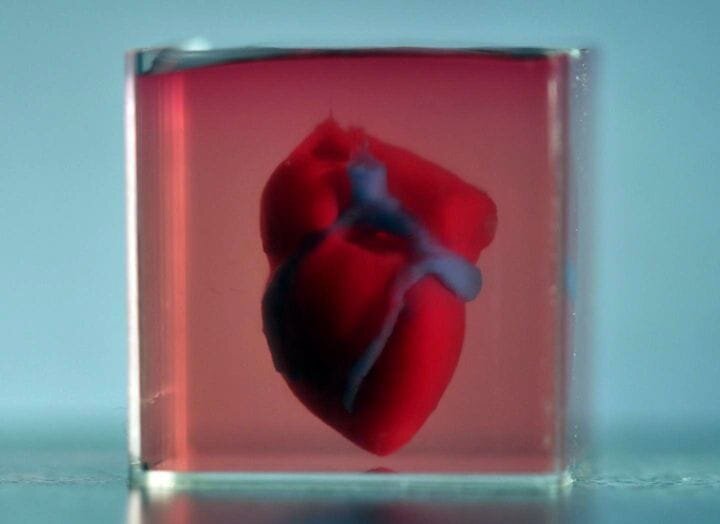![A 3D printed heart [Source: Tel Aviv University]](https://fabbaloo.com/wp-content/uploads/2020/05/image-asset_img_5eb08d521b647.jpg)
In April 2019, a team of Israeli researchers announced a breakthrough finding — for the first time, they had used 3D printing technology to print a heart from human tissue.
Researchers have attempted to print 3D hearts before, but this experiment was the first time anyone had successfully used human tissue to print a heart. Advancements in stem cell and 3D printing technology have begun to enable scientists to create entire organs from scratch.
This heart is a significant development in medical technology made possible by better 3D printing tech and stem cell research. So how did these scientists do it? Further, what does this fabricated heart mean for the future of medicine?
How the Heart Was Printed
Heart disease is the leading cause of death in both men and women in the United States. For years, researchers have wanted to develop 3D printed organs for use in heart transplants, where donors are hard to come by and waitlists can be fatal. Medical researchers have searched for any advantage they can give to doctors, which is why the heart of all organs was one of the first to be 3D printed.
Medical researchers could print tissue before. This ability proved useful for drug testing and regenerative medicine, but it was not the ultimate goal. The tissue printed also did not include blood vessels, which would be necessary when printing a heart.
In this case, the team of researchers was able to recreate the heart’s structure by using stem cells — cells with the potential to differentiate into cells with more specific functions. Researchers extracted fatty tissue from patients and converted these cells into pluripotent stem cells — sometimes called “master” stem cells because of their ability to turn into any kind of cell the body needs.
The researchers then created a hydrogel, made up of collagen and glycoproteins, that could be used as a printing medium by the 3D printer. They added the stem cells into the hydrogel mixture, and the cells then differentiated into the type of cells that make up the walls of blood vessels. The result was a “bioink” based on the patient’s stem cells.
The 3D printer used this bioink to carefully lay down patches of cardiac tissue specific to a patient’s genetic and biochemical makeup. By the end of the experiment, these patches created a heart — about the size of a rabbit’s — made entirely from human tissue.
How 3D-Printed Organs May Change Medicine
Once perfected, organ-printing technology will allow medical manufacturers to create hearts more likely to be accepted by the patient’s immune system.
Any organ donation presents the risk of both short- and long-term rejection. Hearts are especially likely to be rejected. With heart transplants, up to 80% of patients experience at least one rejection episode. In nearly 20% of heart transplants, that rejection proves fatal. A heart printed from tissues that come from a patient’s body will likely reduce — or possibly eliminate — that rejection risk.
The 3D printed heart can’t function in a body yet, however. While it can pull in blood, it can’t yet pump it out. Researchers still need to teach the heart how to beat, then test it in animal models — likely starting with rats. At the same time, the researchers will also explore the feasibility of a human-sized 3D printed heart and identify what new methods they’ll need to learn to get there.
While the heart is a significant development, some medical scientists have declined to call it a breakthrough — a real breakthrough, they argue, would require a fully-functioning human heart. All agree, however, the heart is a major step forward for regenerative medicine — breakthrough or not.
The 3D-printed heart marks another step towards beating one of the most difficult and widespread causes of death in America. Some doctors estimate it may be nearly 10 years before we see this technology used in hospitals. While you shouldn’t expect to see this technology in operating rooms anytime soon, you’re almost certain to hear more from these researchers in the next few years.
The Future of 3D-Printed Organs
While organs have been 3D printed before, this heart marks the first organ printed using only human tissue. The printed heart is a landmark development in regenerative medicine. However, it isn’t usable yet — researchers have a lot of work ahead of them that they will need to complete before 3D organ printing can produce a viable human heart that medical professionals can use in a heart transplant.
If these researchers are successful, the breakthrough could be a major victory against the most common cause of death in the United States. Lower rejection rates, shorter organ waitlists and fewer complications as a result of surgery are all possible benefits of 3D-printed hearts. These 3D-printed organs could also potentially be near-perfect replacements — the best possible fit for a patient.
The heart itself is just the beginning for these researchers. Much work will be necessary for developing an organ suitable for transplant into a patient with end-stage heart failure. Still, this development is a major contribution to regenerative medicine and gives us a glimpse into what the medical field may look like a decade from today.

